Analyzing the Role of Decision-Making in Effective Management
VerifiedAdded on 2023/06/11
|10
|2127
|172
Essay
AI Summary
This essay provides an overview of decision-making in management, emphasizing its crucial role in achieving organizational goals. It explores the planning process, the importance of prioritizing tasks, and the need for contingency plans to address unanticipated events. The essay identifies real-world issues faced by managers, such as inventory control risks, including theft, loss, and damage, and highlights the significance of inventory management and supply chain risk management. It also discusses strategies for mitigating supply chain disruptions and improving inventory supply chain resilience, emphasizing the importance of risk management and information sharing. The essay concludes that effective decision-making is essential for organizational success and requires continuous evaluation and adaptation to achieve desired outcomes. Desklib offers a wide range of similar solved assignments and study resources for students.
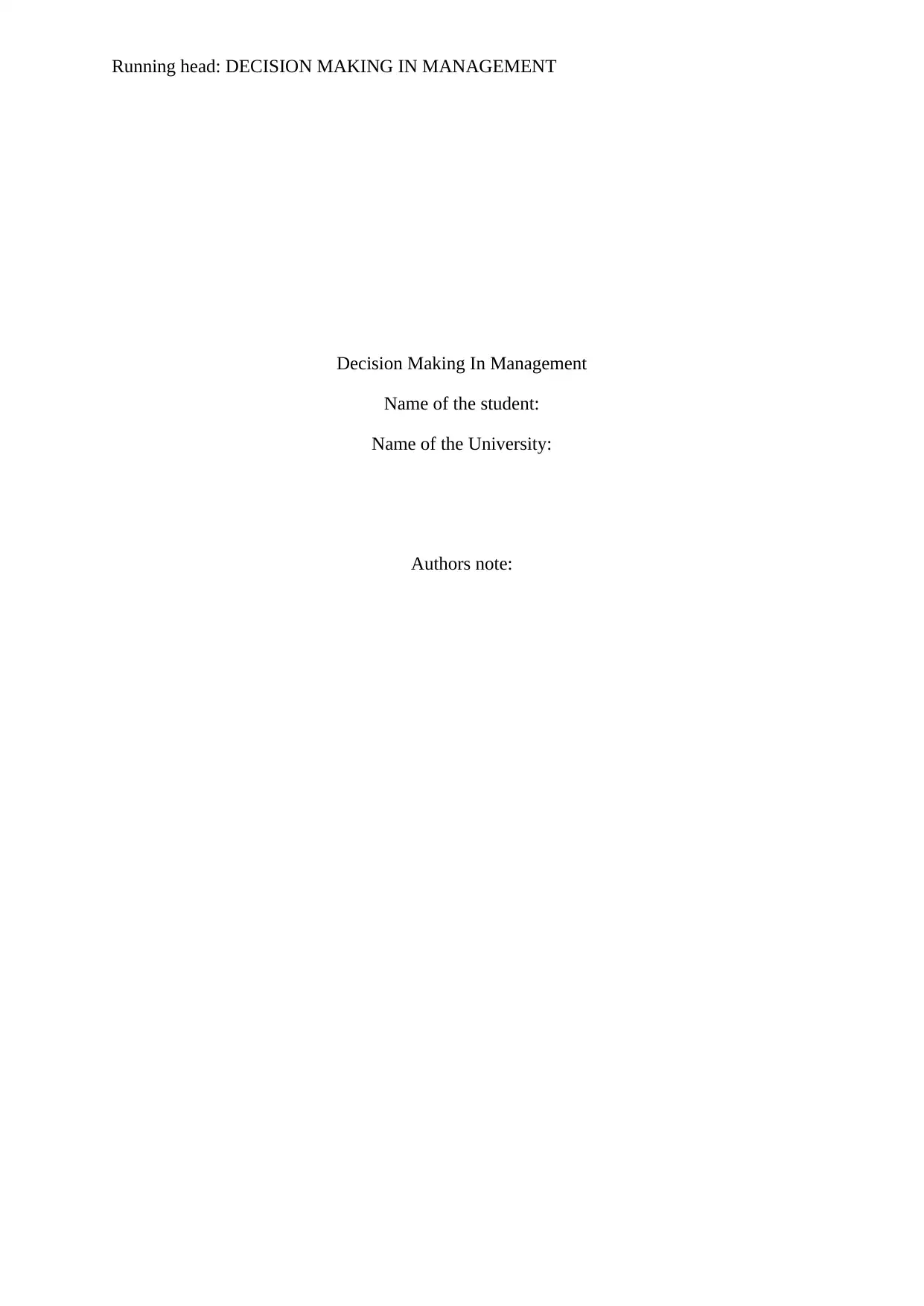
Running head: DECISION MAKING IN MANAGEMENT
Decision Making In Management
Name of the student:
Name of the University:
Authors note:
Decision Making In Management
Name of the student:
Name of the University:
Authors note:
Paraphrase This Document
Need a fresh take? Get an instant paraphrase of this document with our AI Paraphraser
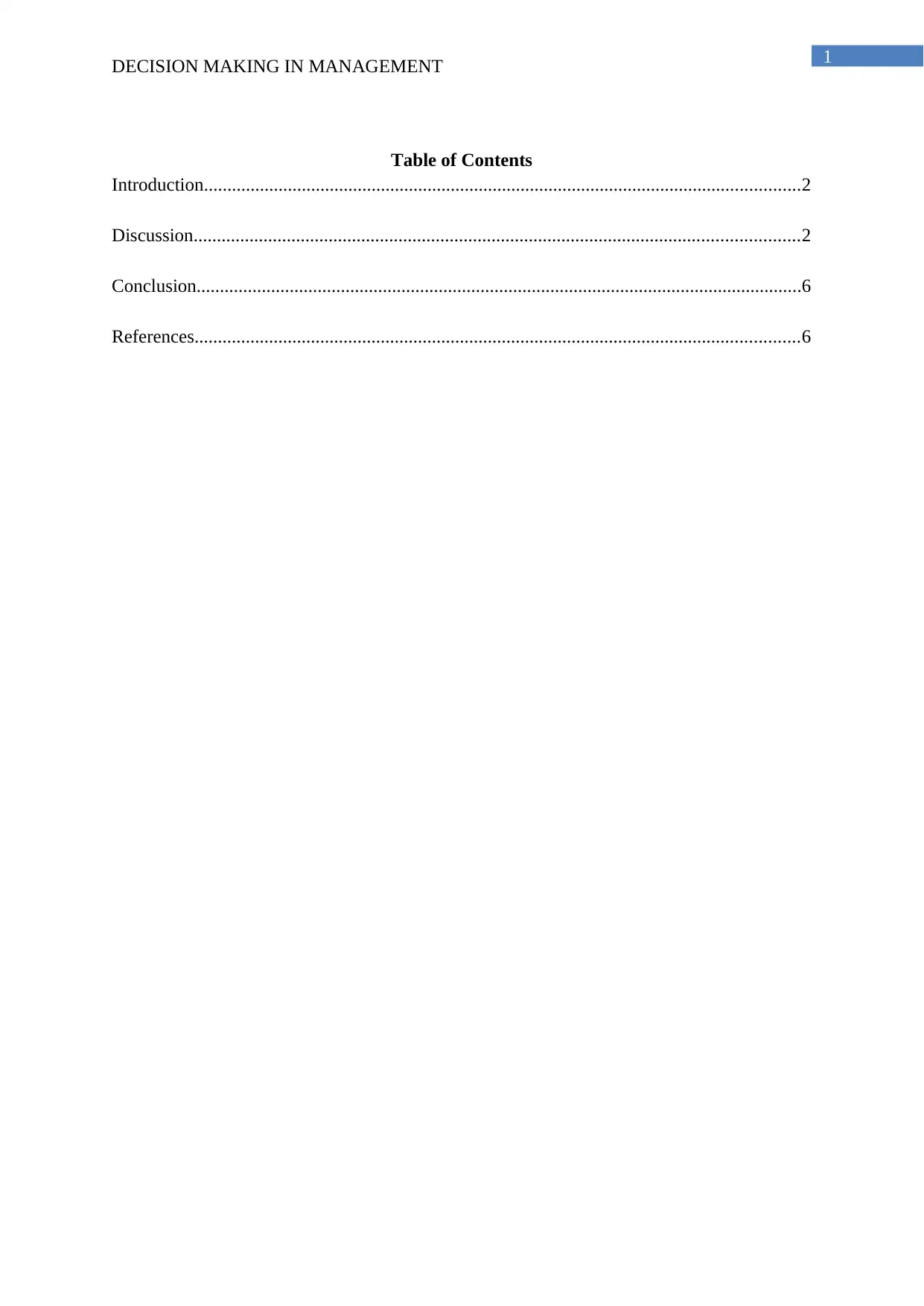
1
DECISION MAKING IN MANAGEMENT
Table of Contents
Introduction................................................................................................................................2
Discussion..................................................................................................................................2
Conclusion..................................................................................................................................6
References..................................................................................................................................6
DECISION MAKING IN MANAGEMENT
Table of Contents
Introduction................................................................................................................................2
Discussion..................................................................................................................................2
Conclusion..................................................................................................................................6
References..................................................................................................................................6
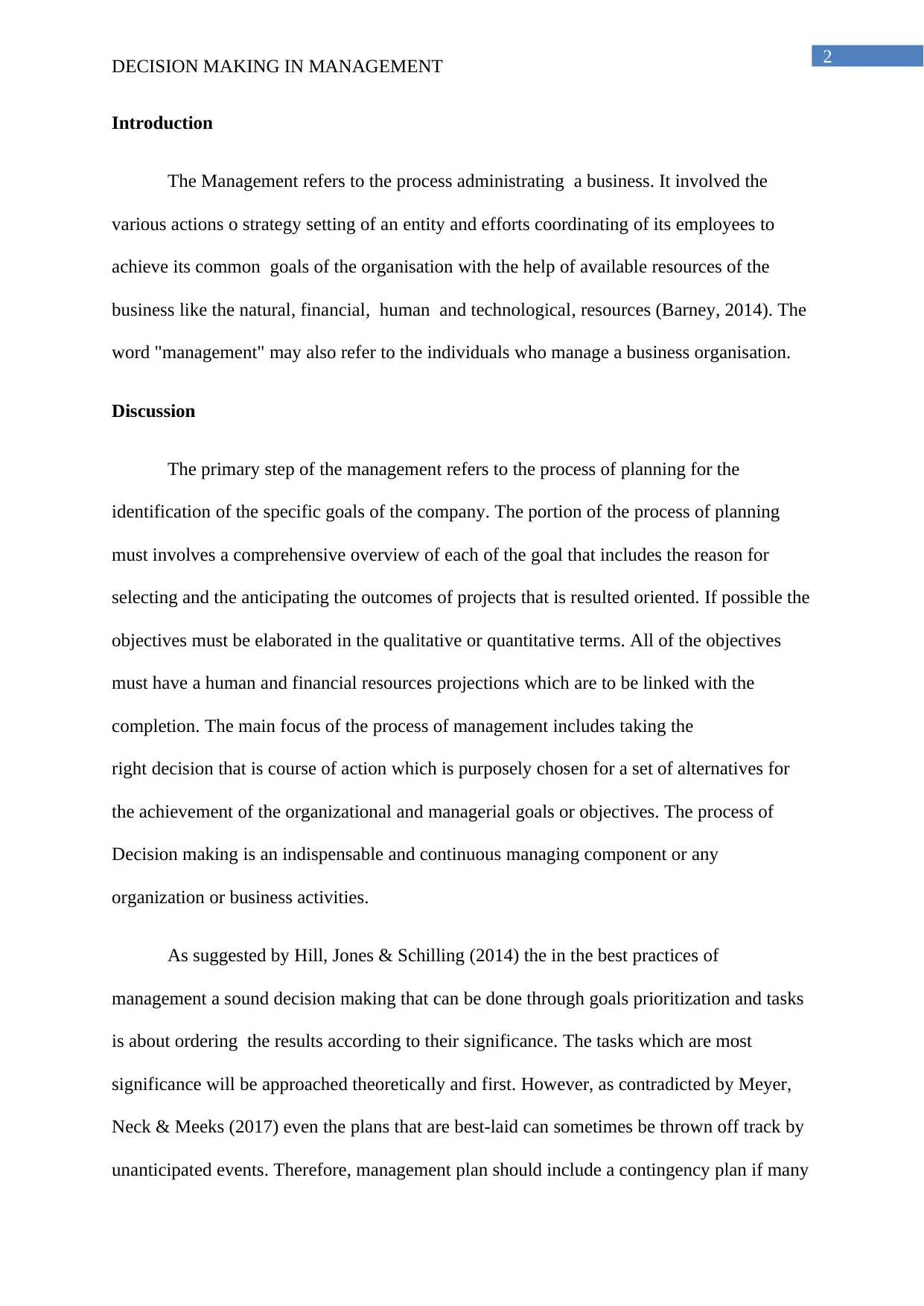
2
DECISION MAKING IN MANAGEMENT
Introduction
The Management refers to the process administrating a business. It involved the
various actions o strategy setting of an entity and efforts coordinating of its employees to
achieve its common goals of the organisation with the help of available resources of the
business like the natural, financial, human and technological, resources (Barney, 2014). The
word "management" may also refer to the individuals who manage a business organisation.
Discussion
The primary step of the management refers to the process of planning for the
identification of the specific goals of the company. The portion of the process of planning
must involves a comprehensive overview of each of the goal that includes the reason for
selecting and the anticipating the outcomes of projects that is resulted oriented. If possible the
objectives must be elaborated in the qualitative or quantitative terms. All of the objectives
must have a human and financial resources projections which are to be linked with the
completion. The main focus of the process of management includes taking the
right decision that is course of action which is purposely chosen for a set of alternatives for
the achievement of the organizational and managerial goals or objectives. The process of
Decision making is an indispensable and continuous managing component or any
organization or business activities.
As suggested by Hill, Jones & Schilling (2014) the in the best practices of
management a sound decision making that can be done through goals prioritization and tasks
is about ordering the results according to their significance. The tasks which are most
significance will be approached theoretically and first. However, as contradicted by Meyer,
Neck & Meeks (2017) even the plans that are best-laid can sometimes be thrown off track by
unanticipated events. Therefore, management plan should include a contingency plan if many
DECISION MAKING IN MANAGEMENT
Introduction
The Management refers to the process administrating a business. It involved the
various actions o strategy setting of an entity and efforts coordinating of its employees to
achieve its common goals of the organisation with the help of available resources of the
business like the natural, financial, human and technological, resources (Barney, 2014). The
word "management" may also refer to the individuals who manage a business organisation.
Discussion
The primary step of the management refers to the process of planning for the
identification of the specific goals of the company. The portion of the process of planning
must involves a comprehensive overview of each of the goal that includes the reason for
selecting and the anticipating the outcomes of projects that is resulted oriented. If possible the
objectives must be elaborated in the qualitative or quantitative terms. All of the objectives
must have a human and financial resources projections which are to be linked with the
completion. The main focus of the process of management includes taking the
right decision that is course of action which is purposely chosen for a set of alternatives for
the achievement of the organizational and managerial goals or objectives. The process of
Decision making is an indispensable and continuous managing component or any
organization or business activities.
As suggested by Hill, Jones & Schilling (2014) the in the best practices of
management a sound decision making that can be done through goals prioritization and tasks
is about ordering the results according to their significance. The tasks which are most
significance will be approached theoretically and first. However, as contradicted by Meyer,
Neck & Meeks (2017) even the plans that are best-laid can sometimes be thrown off track by
unanticipated events. Therefore, management plan should include a contingency plan if many
⊘ This is a preview!⊘
Do you want full access?
Subscribe today to unlock all pages.

Trusted by 1+ million students worldwide
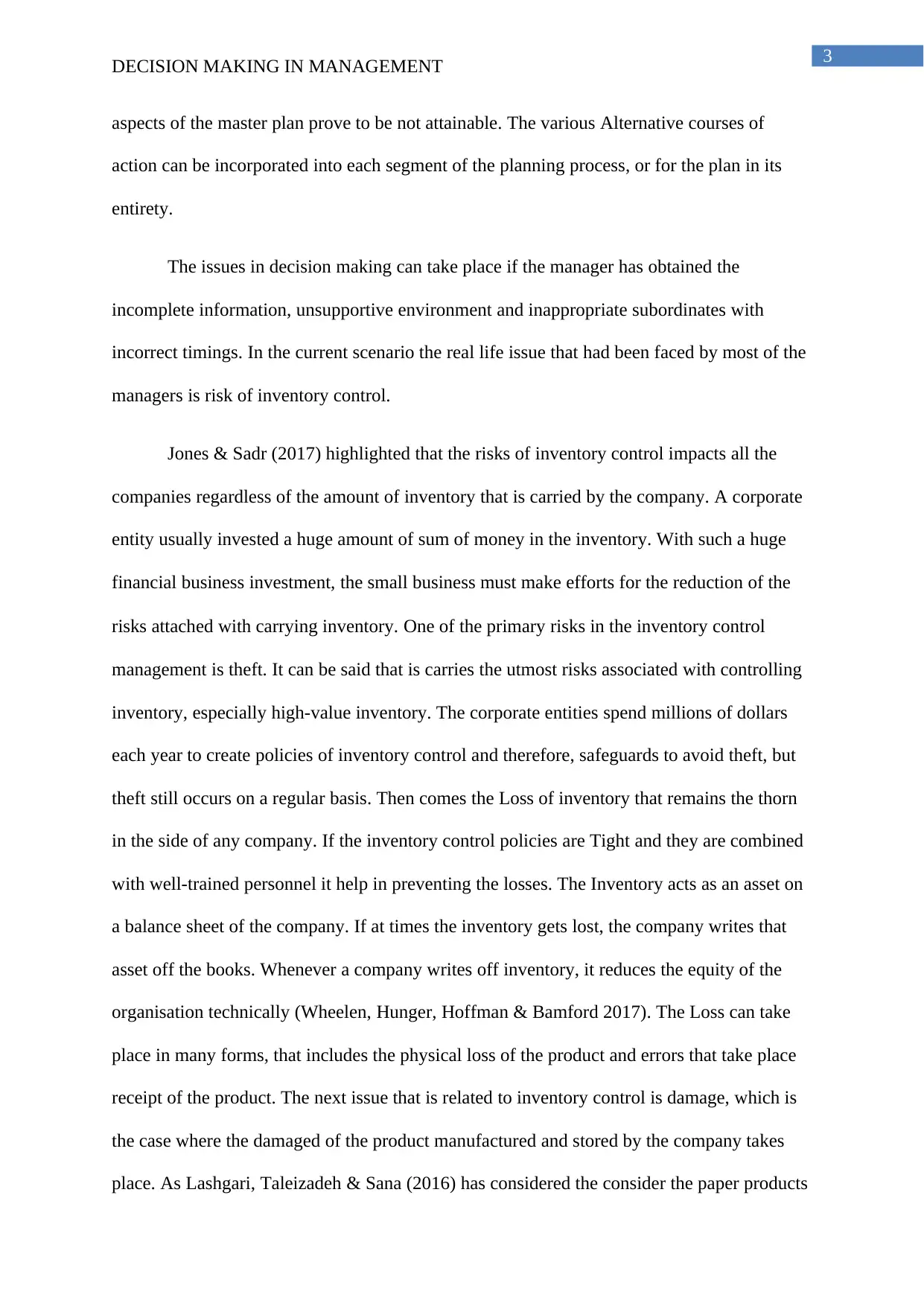
3
DECISION MAKING IN MANAGEMENT
aspects of the master plan prove to be not attainable. The various Alternative courses of
action can be incorporated into each segment of the planning process, or for the plan in its
entirety.
The issues in decision making can take place if the manager has obtained the
incomplete information, unsupportive environment and inappropriate subordinates with
incorrect timings. In the current scenario the real life issue that had been faced by most of the
managers is risk of inventory control.
Jones & Sadr (2017) highlighted that the risks of inventory control impacts all the
companies regardless of the amount of inventory that is carried by the company. A corporate
entity usually invested a huge amount of sum of money in the inventory. With such a huge
financial business investment, the small business must make efforts for the reduction of the
risks attached with carrying inventory. One of the primary risks in the inventory control
management is theft. It can be said that is carries the utmost risks associated with controlling
inventory, especially high-value inventory. The corporate entities spend millions of dollars
each year to create policies of inventory control and therefore, safeguards to avoid theft, but
theft still occurs on a regular basis. Then comes the Loss of inventory that remains the thorn
in the side of any company. If the inventory control policies are Tight and they are combined
with well-trained personnel it help in preventing the losses. The Inventory acts as an asset on
a balance sheet of the company. If at times the inventory gets lost, the company writes that
asset off the books. Whenever a company writes off inventory, it reduces the equity of the
organisation technically (Wheelen, Hunger, Hoffman & Bamford 2017). The Loss can take
place in many forms, that includes the physical loss of the product and errors that take place
receipt of the product. The next issue that is related to inventory control is damage, which is
the case where the damaged of the product manufactured and stored by the company takes
place. As Lashgari, Taleizadeh & Sana (2016) has considered the consider the paper products
DECISION MAKING IN MANAGEMENT
aspects of the master plan prove to be not attainable. The various Alternative courses of
action can be incorporated into each segment of the planning process, or for the plan in its
entirety.
The issues in decision making can take place if the manager has obtained the
incomplete information, unsupportive environment and inappropriate subordinates with
incorrect timings. In the current scenario the real life issue that had been faced by most of the
managers is risk of inventory control.
Jones & Sadr (2017) highlighted that the risks of inventory control impacts all the
companies regardless of the amount of inventory that is carried by the company. A corporate
entity usually invested a huge amount of sum of money in the inventory. With such a huge
financial business investment, the small business must make efforts for the reduction of the
risks attached with carrying inventory. One of the primary risks in the inventory control
management is theft. It can be said that is carries the utmost risks associated with controlling
inventory, especially high-value inventory. The corporate entities spend millions of dollars
each year to create policies of inventory control and therefore, safeguards to avoid theft, but
theft still occurs on a regular basis. Then comes the Loss of inventory that remains the thorn
in the side of any company. If the inventory control policies are Tight and they are combined
with well-trained personnel it help in preventing the losses. The Inventory acts as an asset on
a balance sheet of the company. If at times the inventory gets lost, the company writes that
asset off the books. Whenever a company writes off inventory, it reduces the equity of the
organisation technically (Wheelen, Hunger, Hoffman & Bamford 2017). The Loss can take
place in many forms, that includes the physical loss of the product and errors that take place
receipt of the product. The next issue that is related to inventory control is damage, which is
the case where the damaged of the product manufactured and stored by the company takes
place. As Lashgari, Taleizadeh & Sana (2016) has considered the consider the paper products
Paraphrase This Document
Need a fresh take? Get an instant paraphrase of this document with our AI Paraphraser
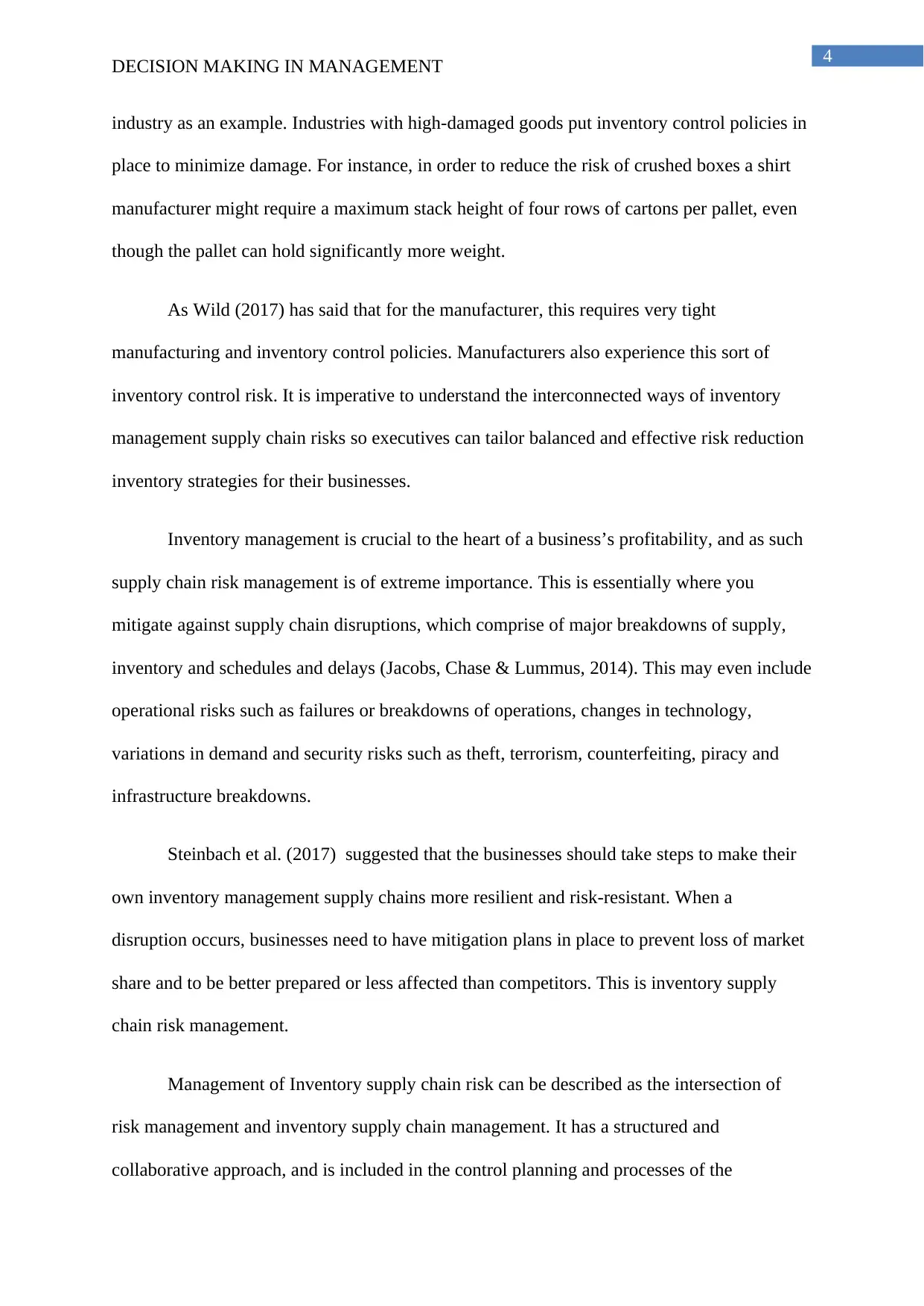
4
DECISION MAKING IN MANAGEMENT
industry as an example. Industries with high-damaged goods put inventory control policies in
place to minimize damage. For instance, in order to reduce the risk of crushed boxes a shirt
manufacturer might require a maximum stack height of four rows of cartons per pallet, even
though the pallet can hold significantly more weight.
As Wild (2017) has said that for the manufacturer, this requires very tight
manufacturing and inventory control policies. Manufacturers also experience this sort of
inventory control risk. It is imperative to understand the interconnected ways of inventory
management supply chain risks so executives can tailor balanced and effective risk reduction
inventory strategies for their businesses.
Inventory management is crucial to the heart of a business’s profitability, and as such
supply chain risk management is of extreme importance. This is essentially where you
mitigate against supply chain disruptions, which comprise of major breakdowns of supply,
inventory and schedules and delays (Jacobs, Chase & Lummus, 2014). This may even include
operational risks such as failures or breakdowns of operations, changes in technology,
variations in demand and security risks such as theft, terrorism, counterfeiting, piracy and
infrastructure breakdowns.
Steinbach et al. (2017) suggested that the businesses should take steps to make their
own inventory management supply chains more resilient and risk-resistant. When a
disruption occurs, businesses need to have mitigation plans in place to prevent loss of market
share and to be better prepared or less affected than competitors. This is inventory supply
chain risk management.
Management of Inventory supply chain risk can be described as the intersection of
risk management and inventory supply chain management. It has a structured and
collaborative approach, and is included in the control planning and processes of the
DECISION MAKING IN MANAGEMENT
industry as an example. Industries with high-damaged goods put inventory control policies in
place to minimize damage. For instance, in order to reduce the risk of crushed boxes a shirt
manufacturer might require a maximum stack height of four rows of cartons per pallet, even
though the pallet can hold significantly more weight.
As Wild (2017) has said that for the manufacturer, this requires very tight
manufacturing and inventory control policies. Manufacturers also experience this sort of
inventory control risk. It is imperative to understand the interconnected ways of inventory
management supply chain risks so executives can tailor balanced and effective risk reduction
inventory strategies for their businesses.
Inventory management is crucial to the heart of a business’s profitability, and as such
supply chain risk management is of extreme importance. This is essentially where you
mitigate against supply chain disruptions, which comprise of major breakdowns of supply,
inventory and schedules and delays (Jacobs, Chase & Lummus, 2014). This may even include
operational risks such as failures or breakdowns of operations, changes in technology,
variations in demand and security risks such as theft, terrorism, counterfeiting, piracy and
infrastructure breakdowns.
Steinbach et al. (2017) suggested that the businesses should take steps to make their
own inventory management supply chains more resilient and risk-resistant. When a
disruption occurs, businesses need to have mitigation plans in place to prevent loss of market
share and to be better prepared or less affected than competitors. This is inventory supply
chain risk management.
Management of Inventory supply chain risk can be described as the intersection of
risk management and inventory supply chain management. It has a structured and
collaborative approach, and is included in the control planning and processes of the
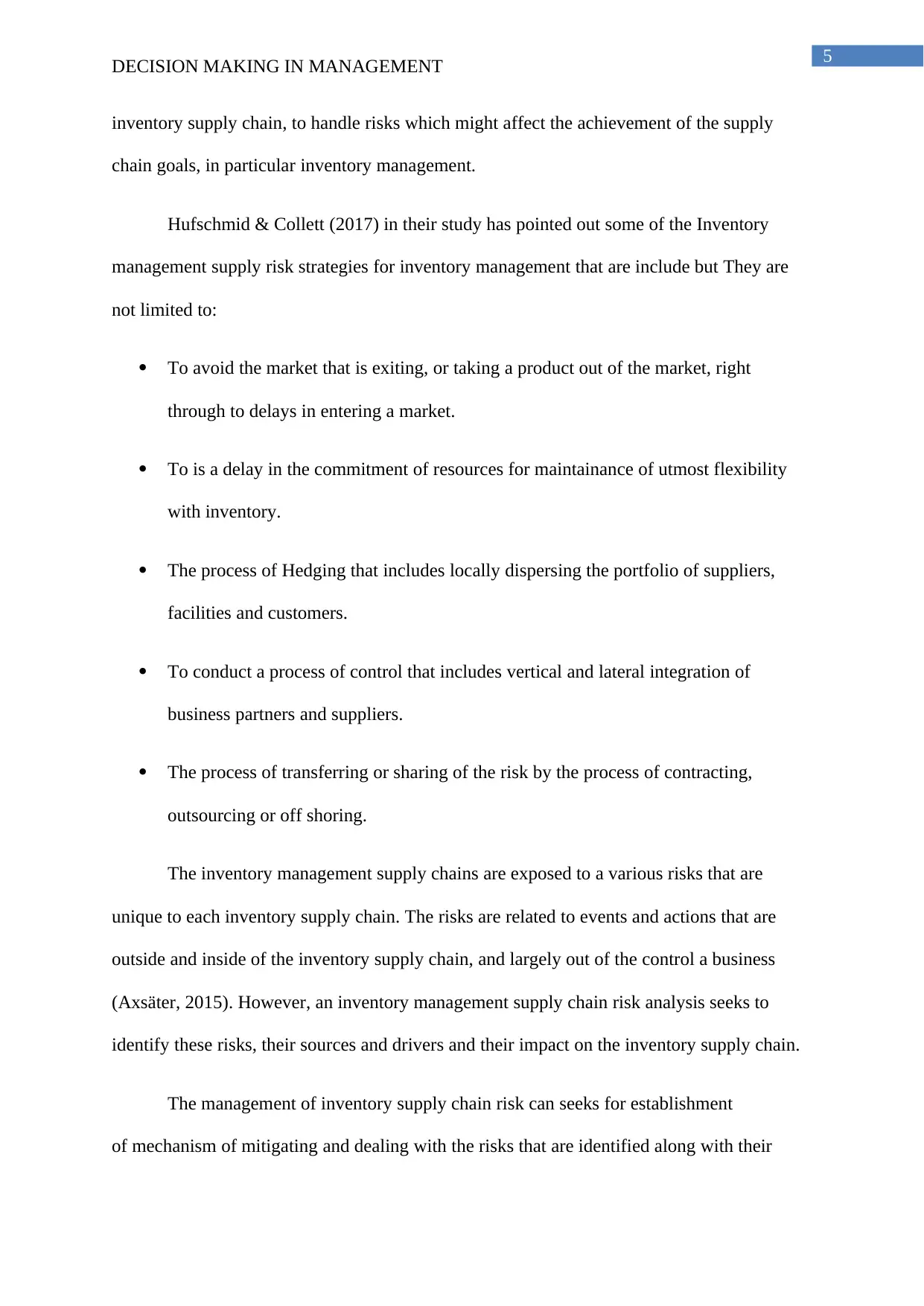
5
DECISION MAKING IN MANAGEMENT
inventory supply chain, to handle risks which might affect the achievement of the supply
chain goals, in particular inventory management.
Hufschmid & Collett (2017) in their study has pointed out some of the Inventory
management supply risk strategies for inventory management that are include but They are
not limited to:
To avoid the market that is exiting, or taking a product out of the market, right
through to delays in entering a market.
To is a delay in the commitment of resources for maintainance of utmost flexibility
with inventory.
The process of Hedging that includes locally dispersing the portfolio of suppliers,
facilities and customers.
To conduct a process of control that includes vertical and lateral integration of
business partners and suppliers.
The process of transferring or sharing of the risk by the process of contracting,
outsourcing or off shoring.
The inventory management supply chains are exposed to a various risks that are
unique to each inventory supply chain. The risks are related to events and actions that are
outside and inside of the inventory supply chain, and largely out of the control a business
(Axsäter, 2015). However, an inventory management supply chain risk analysis seeks to
identify these risks, their sources and drivers and their impact on the inventory supply chain.
The management of inventory supply chain risk can seeks for establishment
of mechanism of mitigating and dealing with the risks that are identified along with their
DECISION MAKING IN MANAGEMENT
inventory supply chain, to handle risks which might affect the achievement of the supply
chain goals, in particular inventory management.
Hufschmid & Collett (2017) in their study has pointed out some of the Inventory
management supply risk strategies for inventory management that are include but They are
not limited to:
To avoid the market that is exiting, or taking a product out of the market, right
through to delays in entering a market.
To is a delay in the commitment of resources for maintainance of utmost flexibility
with inventory.
The process of Hedging that includes locally dispersing the portfolio of suppliers,
facilities and customers.
To conduct a process of control that includes vertical and lateral integration of
business partners and suppliers.
The process of transferring or sharing of the risk by the process of contracting,
outsourcing or off shoring.
The inventory management supply chains are exposed to a various risks that are
unique to each inventory supply chain. The risks are related to events and actions that are
outside and inside of the inventory supply chain, and largely out of the control a business
(Axsäter, 2015). However, an inventory management supply chain risk analysis seeks to
identify these risks, their sources and drivers and their impact on the inventory supply chain.
The management of inventory supply chain risk can seeks for establishment
of mechanism of mitigating and dealing with the risks that are identified along with their
⊘ This is a preview!⊘
Do you want full access?
Subscribe today to unlock all pages.

Trusted by 1+ million students worldwide
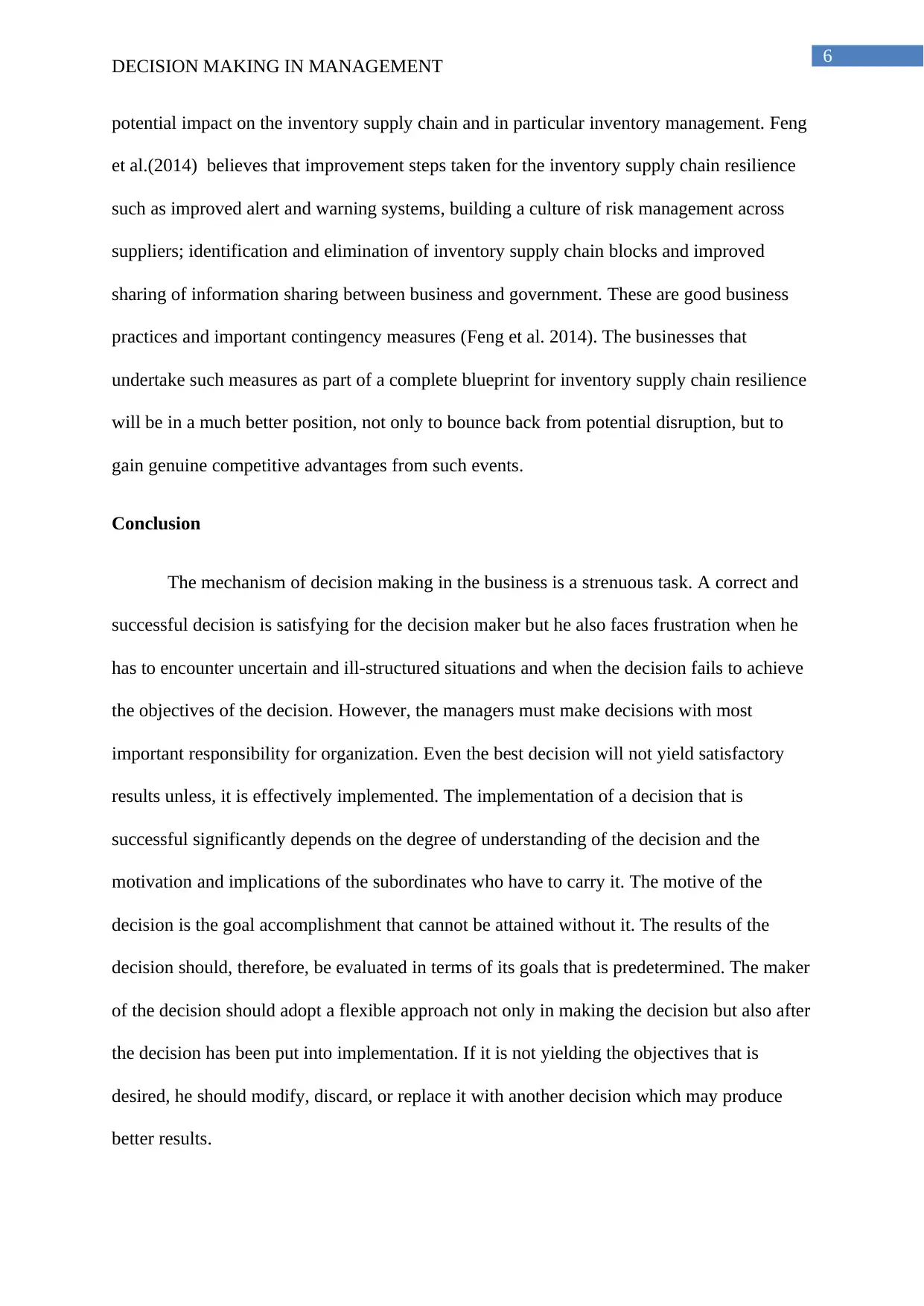
6
DECISION MAKING IN MANAGEMENT
potential impact on the inventory supply chain and in particular inventory management. Feng
et al.(2014) believes that improvement steps taken for the inventory supply chain resilience
such as improved alert and warning systems, building a culture of risk management across
suppliers; identification and elimination of inventory supply chain blocks and improved
sharing of information sharing between business and government. These are good business
practices and important contingency measures (Feng et al. 2014). The businesses that
undertake such measures as part of a complete blueprint for inventory supply chain resilience
will be in a much better position, not only to bounce back from potential disruption, but to
gain genuine competitive advantages from such events.
Conclusion
The mechanism of decision making in the business is a strenuous task. A correct and
successful decision is satisfying for the decision maker but he also faces frustration when he
has to encounter uncertain and ill-structured situations and when the decision fails to achieve
the objectives of the decision. However, the managers must make decisions with most
important responsibility for organization. Even the best decision will not yield satisfactory
results unless, it is effectively implemented. The implementation of a decision that is
successful significantly depends on the degree of understanding of the decision and the
motivation and implications of the subordinates who have to carry it. The motive of the
decision is the goal accomplishment that cannot be attained without it. The results of the
decision should, therefore, be evaluated in terms of its goals that is predetermined. The maker
of the decision should adopt a flexible approach not only in making the decision but also after
the decision has been put into implementation. If it is not yielding the objectives that is
desired, he should modify, discard, or replace it with another decision which may produce
better results.
DECISION MAKING IN MANAGEMENT
potential impact on the inventory supply chain and in particular inventory management. Feng
et al.(2014) believes that improvement steps taken for the inventory supply chain resilience
such as improved alert and warning systems, building a culture of risk management across
suppliers; identification and elimination of inventory supply chain blocks and improved
sharing of information sharing between business and government. These are good business
practices and important contingency measures (Feng et al. 2014). The businesses that
undertake such measures as part of a complete blueprint for inventory supply chain resilience
will be in a much better position, not only to bounce back from potential disruption, but to
gain genuine competitive advantages from such events.
Conclusion
The mechanism of decision making in the business is a strenuous task. A correct and
successful decision is satisfying for the decision maker but he also faces frustration when he
has to encounter uncertain and ill-structured situations and when the decision fails to achieve
the objectives of the decision. However, the managers must make decisions with most
important responsibility for organization. Even the best decision will not yield satisfactory
results unless, it is effectively implemented. The implementation of a decision that is
successful significantly depends on the degree of understanding of the decision and the
motivation and implications of the subordinates who have to carry it. The motive of the
decision is the goal accomplishment that cannot be attained without it. The results of the
decision should, therefore, be evaluated in terms of its goals that is predetermined. The maker
of the decision should adopt a flexible approach not only in making the decision but also after
the decision has been put into implementation. If it is not yielding the objectives that is
desired, he should modify, discard, or replace it with another decision which may produce
better results.
Paraphrase This Document
Need a fresh take? Get an instant paraphrase of this document with our AI Paraphraser
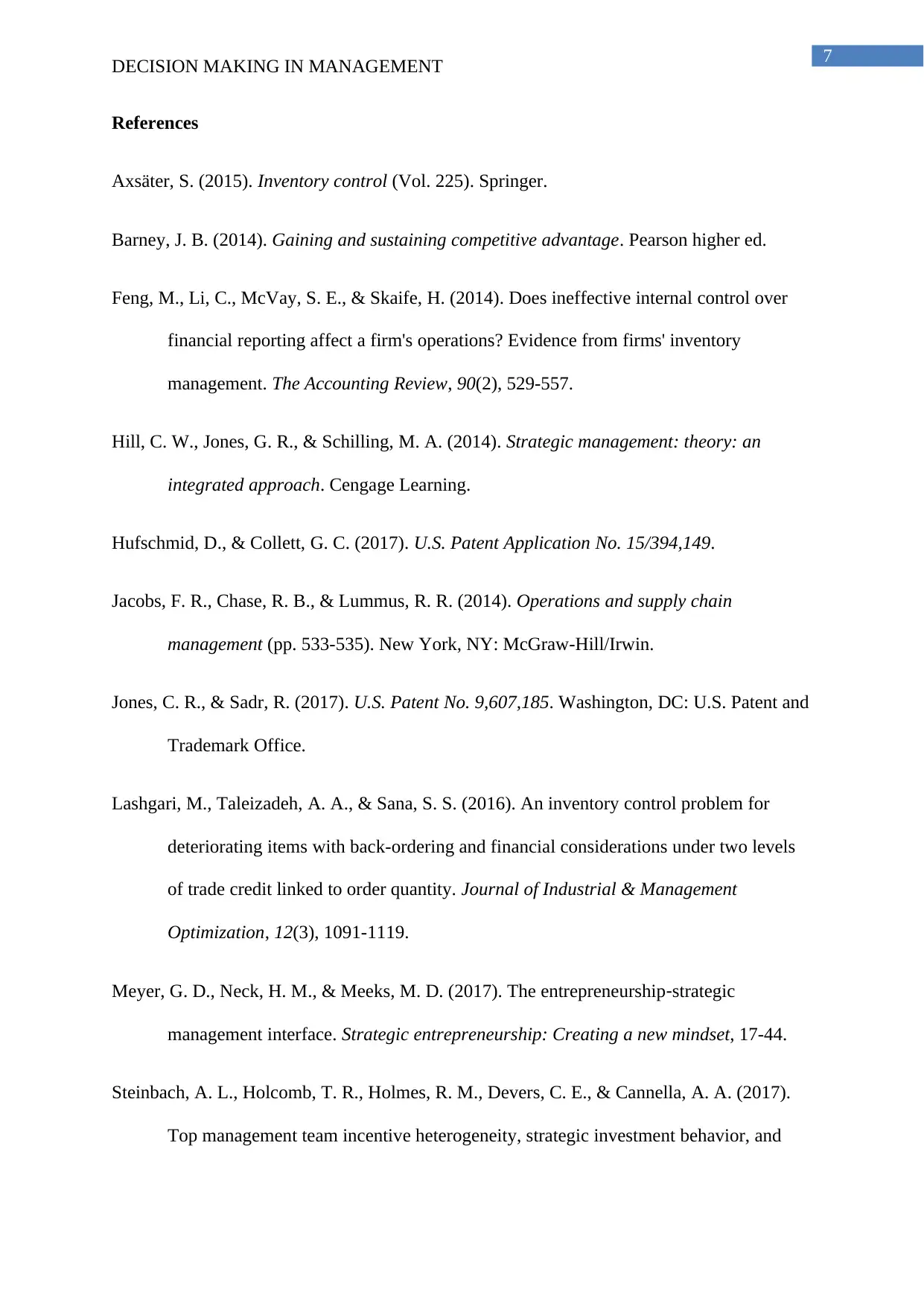
7
DECISION MAKING IN MANAGEMENT
References
Axsäter, S. (2015). Inventory control (Vol. 225). Springer.
Barney, J. B. (2014). Gaining and sustaining competitive advantage. Pearson higher ed.
Feng, M., Li, C., McVay, S. E., & Skaife, H. (2014). Does ineffective internal control over
financial reporting affect a firm's operations? Evidence from firms' inventory
management. The Accounting Review, 90(2), 529-557.
Hill, C. W., Jones, G. R., & Schilling, M. A. (2014). Strategic management: theory: an
integrated approach. Cengage Learning.
Hufschmid, D., & Collett, G. C. (2017). U.S. Patent Application No. 15/394,149.
Jacobs, F. R., Chase, R. B., & Lummus, R. R. (2014). Operations and supply chain
management (pp. 533-535). New York, NY: McGraw-Hill/Irwin.
Jones, C. R., & Sadr, R. (2017). U.S. Patent No. 9,607,185. Washington, DC: U.S. Patent and
Trademark Office.
Lashgari, M., Taleizadeh, A. A., & Sana, S. S. (2016). An inventory control problem for
deteriorating items with back-ordering and financial considerations under two levels
of trade credit linked to order quantity. Journal of Industrial & Management
Optimization, 12(3), 1091-1119.
Meyer, G. D., Neck, H. M., & Meeks, M. D. (2017). The entrepreneurship‐strategic
management interface. Strategic entrepreneurship: Creating a new mindset, 17-44.
Steinbach, A. L., Holcomb, T. R., Holmes, R. M., Devers, C. E., & Cannella, A. A. (2017).
Top management team incentive heterogeneity, strategic investment behavior, and
DECISION MAKING IN MANAGEMENT
References
Axsäter, S. (2015). Inventory control (Vol. 225). Springer.
Barney, J. B. (2014). Gaining and sustaining competitive advantage. Pearson higher ed.
Feng, M., Li, C., McVay, S. E., & Skaife, H. (2014). Does ineffective internal control over
financial reporting affect a firm's operations? Evidence from firms' inventory
management. The Accounting Review, 90(2), 529-557.
Hill, C. W., Jones, G. R., & Schilling, M. A. (2014). Strategic management: theory: an
integrated approach. Cengage Learning.
Hufschmid, D., & Collett, G. C. (2017). U.S. Patent Application No. 15/394,149.
Jacobs, F. R., Chase, R. B., & Lummus, R. R. (2014). Operations and supply chain
management (pp. 533-535). New York, NY: McGraw-Hill/Irwin.
Jones, C. R., & Sadr, R. (2017). U.S. Patent No. 9,607,185. Washington, DC: U.S. Patent and
Trademark Office.
Lashgari, M., Taleizadeh, A. A., & Sana, S. S. (2016). An inventory control problem for
deteriorating items with back-ordering and financial considerations under two levels
of trade credit linked to order quantity. Journal of Industrial & Management
Optimization, 12(3), 1091-1119.
Meyer, G. D., Neck, H. M., & Meeks, M. D. (2017). The entrepreneurship‐strategic
management interface. Strategic entrepreneurship: Creating a new mindset, 17-44.
Steinbach, A. L., Holcomb, T. R., Holmes, R. M., Devers, C. E., & Cannella, A. A. (2017).
Top management team incentive heterogeneity, strategic investment behavior, and
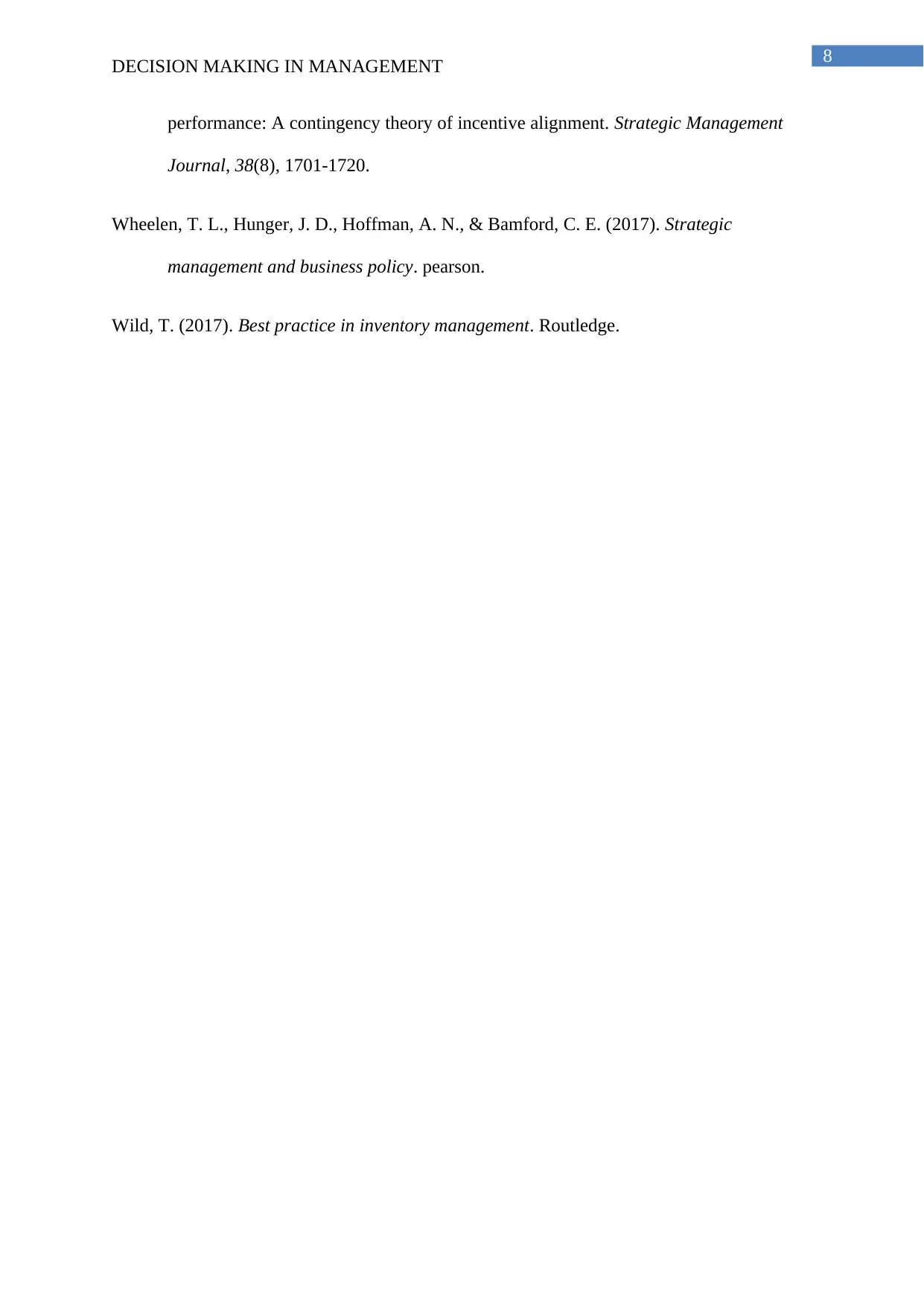
8
DECISION MAKING IN MANAGEMENT
performance: A contingency theory of incentive alignment. Strategic Management
Journal, 38(8), 1701-1720.
Wheelen, T. L., Hunger, J. D., Hoffman, A. N., & Bamford, C. E. (2017). Strategic
management and business policy. pearson.
Wild, T. (2017). Best practice in inventory management. Routledge.
DECISION MAKING IN MANAGEMENT
performance: A contingency theory of incentive alignment. Strategic Management
Journal, 38(8), 1701-1720.
Wheelen, T. L., Hunger, J. D., Hoffman, A. N., & Bamford, C. E. (2017). Strategic
management and business policy. pearson.
Wild, T. (2017). Best practice in inventory management. Routledge.
⊘ This is a preview!⊘
Do you want full access?
Subscribe today to unlock all pages.

Trusted by 1+ million students worldwide

9
DECISION MAKING IN MANAGEMENT
DECISION MAKING IN MANAGEMENT
1 out of 10
Related Documents
Your All-in-One AI-Powered Toolkit for Academic Success.
+13062052269
info@desklib.com
Available 24*7 on WhatsApp / Email
![[object Object]](/_next/static/media/star-bottom.7253800d.svg)
Unlock your academic potential
Copyright © 2020–2025 A2Z Services. All Rights Reserved. Developed and managed by ZUCOL.





